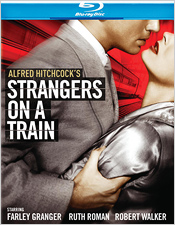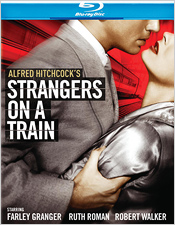Strangers on a Train (Blu-ray Review)

Director
Alfred HitchcockRelease Date(s)
1951 (October 9, 2012)Studio(s)
Warner Bros. Pictures (Warner Bros.)- Film/Program Grade: A
- Video Grade: A-
- Audio Grade: C-
- Extras Grade: B
Review
Will the real Alfred Hitchcock please stand up?
Although Hitchcock died in 1980, interest in the great director might be at an all-time high. Two competing biopics are attempting to penetrate the man behind the myth; Toby Jones has stepped into his shoes for HBO’s The Girl, portraying Hitchcock as Tippi Hedren’s obsessive tormentor on the set of The Birds. For the theatrical release Hitchcock, Anthony Hopkins has filled the familiar silhouette as a Psycho-era portrait of an auteur. For the real Alfred Hitchcock, though, the curious need only turn to his films, as remarkable a legacy in cinema as exists. Though Universal is prepping the 15-film Blu-ray Masterpiece Collection for release later this month, Warner Bros. has offered up a sort of appetizer via two of Hitch’s earlier films, both making Blu-ray debuts: 1954’s Dial “M” For Murder and 1951’s Strangers on a Train. Strangers itself is an exploration of duality, and its BD debut likewise offers both positive and negative aspects.
Though Strangers hasn’t, in the ensuing years, been as widely acknowledged as some of Hitchcock’s other premier films, it holds up remarkably well as an example of the approach that was so singular to the director. Hitchcock imposed a near-obsessive concept on the film without overpowering it, and followed through with that concept, its visuals growing only more fascinating on repeated viewings. Always keenly interested in the good and evil inherent to human nature, Hitchcock was naturally attracted to Patricia Highsmith’s novel about a playboy who, in a chance encounter on a train, proposes that he “exchange murders” with a complete stranger. In the movie, Robert Walker is the bon vivant Bruno Anthony, while Farley Granger plays Guy Haines, an architect in Highsmith’s book but a tennis player with political aspirations in the screenplay credited to Raymond Chandler and Czenzi Ormonde. Though Guy demurs, Bruno goes ahead with the first murder, anyway, and Guy’s life is turned upside down.
The very first shots of the film, beautifully rendered on this near-pristine hi-def transfer, reveal the two strangers, but the camera follows them from the knees down. The audience is forced to focus on their gaits, their shoes, their luggage, their trousers – and each image tells us more about these characters than even dialogue could. Hitchcock introduces the motif of twos into the film: not just the two legs and two feet, but the two train tracks ahead of the locomotive: which track will it take? He returns throughout the 101-minute movie, time and again, to the contrasts of twos, both visually and in the dialogue. Two men and two murders is just the beginning. Soon after the men’s faces are finally revealed on the train, a drink is ordered of “scotch and plain water” by the swaggering Bruno for the diffident Guy. He then asks the waiter for “a pair… doubles.” Bruno is also making a tennis reference. The director establishes roiling tension in this pivotal opening sequence, contrasting the foppish, ne’er-do-well Bruno with the nervous, cuckolded Guy. Bruno plans to kill Guy’s unfaithful wife Miriam (Kasey Rogers, as Laura Elliott) in a “criss-cross” murder in which Guy will then kill his overbearing father (Jonathan Hale). Of course, Guy, too, has another relationship with the lovely and pure Ann Morton, portrayed by Ruth Roman. No man, including our ostensible “hero,” is without his dual nature, after all. Hitchcock returned time and again to the story of an innocent man being pursued – but is he really innocent? Guy’s cigarette lighter, with its criss-crossed tennis rackets, is yet another visual motif that plays an important part in the story.
Granger’s deep, sad eyes frequently reveal what’s going on underneath the surface of his character, thrust into a situation he never imagined. Walker is beautifully creepy as the amoral, cool-as-a-cucumber sociopath. Walker’s Bruno frequently stands alone in the film, whether memorably placed as a visual stain on the pure grandeur of the Jefferson Memorial in Washington, DC, or staring straight ahead at a tennis match while the rest of the audience’s heads bob back and forth following the ball. They evince quite a rapport onscreen, making it hard to ignore Strangers’ much-dissected homosexual subtext. While it remains just that, there’s no denying that Hitchcock pushed the envelope as Bruno pouts to the object of his pursuit, “But Guy, I like you,” and Guy “makes up” with him, straightening Bruno’s tie. There is great intimacy and physical proximity between the two men in various shots, further reflecting the idea of two halves of a single personality. Needless to say, there’s eventually a double cross (emphasis mine) that separates them with devastating results.
Hitchcock was an artist in black-and-white, and the tones and contrasts in the new BD presentation are nothing short of stunning. Cinematographer Robert Burks, beginning a long, twelve-picture association with the director, received his only Academy Award nomination for his work on Strangers, and it’s easy to see why. The evening sequences are particularly thrilling, including the moments when Bruno follows his target Miriam and her two (of course) male suitors through an amusement park, seducing her with his intent eyes amidst the Tilt-a-Whirl, Tunnel of Love and a merry-go-round that will play a major role late in the film. The murder itself, seen as the reflection in the victim’s broken eyeglass lens, is one more component of the director’s thoroughly artful design.
Though it never feels overlong, Strangers on a Train is deliberate; its suspense builds slowly, often silently. Hitchcock being Hitchcock, he added sly comic relief in the form of two enduring performances by supporting cast members. His daughter Patricia Hitchcock plays Barbara, the suspicious and wisecracking sister of Guy’s paramour Ann who happens to wear glasses just like those worn by Miriam. (Barbara and Miriam - doubles again.) Marian Lorne, later Aunt Clara on television’s Bewitched, is pitch-perfect as Bruno’s dementedly daffy mother. In just two short scenes, Lorne is both sweetly bewildering and altogether chilling as she manicures her son’s nails, or blithely shows off a rather disturbing painting she’s created. (In another Bewitched connection, Kasey Rogers went on to replace Irene Vernon as Louise Tate in the sitcom’s third season.)
The crisp 1080p, AVC-encoded 1:36:1 transfer is one of the best yet for a Hitchcock film on Blu-ray, with its natural grain and gorgeous blacks and whites bringing to life the film’s suspense. The famous, climactic carousel set piece looks better than ever, but the shadows that, yes, criss-cross Bruno and Guy’s faces are also sharply detailed. The sound is less impressive, though mono track is certainly acceptable for both dialogue and music. Dmitri Tiomkin was responsible for the score to Strangers. His prominent orchestral score is very much in the style of the era, dramatically echoing the onscreen action. But Hitchcock, always astute to the possibilities offered by music, knows when to jettison it, too. A sequence of Guy playing in a tennis match is cross-cut with an edge-of-your-seat scene in which Bruno returns to the scene of the crime to frame his friend. Hitchcock smartly allows silence and ambient noise to score much of the sequence. Without the music as an emotional guide, you’re even more focused on the visual contrasts, including Guy’s pure white attire to Bruno’s darkly-clad suit. Even the tennis announcer’s dialogue is imbued with a double meaning; “Advantage, Mr. Haines!” adds to the high stakes. The BD offers DTS-HD Master Audio English Mono (1.0), in addition to mono Dolby Digital tracks in English, French, German, Italian, Spanish (both Castilian and Latin) and Portuguese. English SDH, French, German, Italian, Spanish (Castilian and Latin) and Portuguese subtitles are also included.
The nearly-flawless transfer is reason enough to recommend Warner’s new BD. Unfortunately for those who already owned Strangers in the studio’s previous 2-DVD edition from 2004, the special features are identical. An entertaining commentary is offered from Hitchcock’s friend and fellow director Peter Bogdanovich, who is joined by historian Andrew Wilson, Psycho screenwriter Joseph Stefano, and others. The centerpiece of the bonus features is the half-hour-plus documentary Strangers on a Train: A Hitchcock Classic, directed by Laurent Bouzereau and featuring interviews with the above gentlemen plus Robert Osborne, Richard Schickel, Farley Granger, Patricia Hitchcock O’Connell, Robert Walker, Jr. and Dmitri Tiomkin’s widow Olivia Douglas. The documentary swiftly covers all of the bases, exploring the movie’s themes and sharing history on its background (from the departures from the original novel, to the revolving door of screenwriters). It’s still a treat to see Robert Walker, Jr., looking and sounding like a dead ringer for his late father, who died less than two months after the release of Strangers. A familiar topic of discussion for the participants is Hitchcock’s visual artistry.
The documentary also tells the story of the film’s Preview Version, which is also included in full on the new Blu-ray, as it was on the 2004 DVD. This slightly longer cut of the film has a less satisfying conclusion and a few other key differences. Alas, it’s only been transferred in 480i for the new edition, paling in comparison to the original feature’s newly vivid clarity. The theatrical trailer and a handful of shorter featurettes have also been imported from the ’04 DVD. Best of these is The Victim’s POV, a 12-minute mini-doc featuring Kasey Rogers recalling her days spent on Warner Bros.’ Strangers set on loan from Paramount Pictures. The brief newsreel first included on the 1998 Strangers DVD has also been retained. New bonus material would have been welcome, especially pertaining to the BD transfer. But there’s a special resonance now in the interviews of the artists who have passed away since the Bouzereau film was made, including both Granger and Rogers.
The offscreen drama might not have been as high on Strangers on a Train as on Psycho or The Birds, and its visuals might not be as iconic as those of Vertigo. But Alfred Hitchcock felt that his first film for Warner Bros. was a meaningful one, and in many ways his first “true” American motion picture. It also restored Hitchcock to a place of prominence in the Hollywood firmament following the less well-received Under Capricorn and Stage Fright. Thanks to this beautifully-restored Blu-ray print, Strangers’ dramatic tale of psychological suspense has hardly aged a day… or two.
- Joe Marchese

